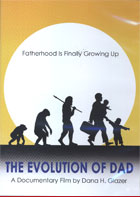
The Evolution of Dad 2010
Distributed by Dane-Gramp Productions, 61 Clinton Ave., Richmond, NJ 07450; 917-685-9056
Produced by Alvaro Donado and Dana H. Glazer
Directed by Dana H. Glazer
DVD, color, 94 min.
Jr. High - Adult
20th C. American History, Male Parenting, Family Dynamics
Date Entered: 04/07/2011
Reviewed by Christopher Lewis, American University Library, American UniversityFilmmaker Dana Glaser, a father of two, probes the shift in roles and expectations of fathers in the U.S. The film tracks the evolution of the average father from 18th century farmer to 19th century factory worker and into the present. When a high number of women joined the workforce during World War II men’s roles began to gradually change. Following the war there was a retreat to the traditional workaholic father/ homemaker mother family but the social upheaval of the sixties changed that. Flash forward to today where there are roughly equal numbers of men and women in the workforce and more men staying home raising their children. How men cope with these new roles and an examination of the (often contradictory) pressures society puts on them comprises the rest of the film.
The first stay-at-home father introduced is Dallas, who’s raising a toddler son. He changes diapers with as much gusto as anybody you’re likely to encounter. He’s fully adjusted and doesn’t seem to have any insecurity about his choice.
There’s also Paul who successfully raised two children to adulthood while his wife climbed the corporate ladder. His children have fond memories of the experience though there’s evidence that it took a toll on his sense of self-esteem. His social life is minimal and his children seem to have concern about his needs.
Interspersed through the case studies are interviews with authors, psychologists, and other experts who support the position that there is widespread discrimination against stay-at-home fathers on corporate, government, and social fronts. Person on the street interviews disparaging home fathers and interviews with men who have dealt with discrimination directly bear this out. There’s a Maryland state trooper who had to sue for FMLA benefits, a father prohibited from attending a Mommy and Me playgroup, and a father who had to fight to get joint custody after a divorce.
The most moving (and heartbreaking) portrait of the stay-at-home father is of Ralph, who’s in fact a grandfather. He’s not only raising his granddaughter Kayla but stands in as a surrogate for a host of children whose fathers aren’t around. Ralph credits fatherhood for salvaging a life that had spiraled into drug addiction and in fact we learn he’s living with AIDS. Sadly by the end of the film Ralph dies, leaving a huge hole in his family.
The film has a strong thesis and is well presented. The cases are all interesting and will resonate with the viewer. The film isn’t without shortcomings though. The names and titles of the subjects are oversized and run off the frame to the extent of being unreadable. The film is also 94 minutes long including a 4 ½ minute opening montage of images and sound clips of people talking about fathers. At this length it’s hard to imagine for whom it’s intended. It would seem too long for public TV or classroom use. The film is exceptional in that it’s taken on a widespread change in our society that’s gotten little attention and handles it well. For that, it’s recommended for all academic and public libraries. It will be of particular interest to those with interest in sociology and anthropology.